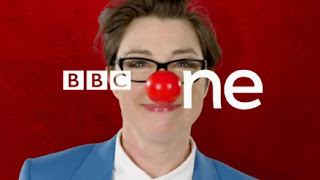In the first sting I watched which was for comic relief on the BBC was based around informing people about something related to comic relief coming up soon on the channel and gives out information to the viewers. I chose to do describe this sting because of the meaning behind it (informing people) and also the spread of colour catches the eye of whoever is looking at this sting. The red nose on the lady to replace the O in BBC 'O'ne.
The second sting I watched was for the upcoming FA Cup final at the time for Arsenal vs Chelsea. It was similar to the first sting as it had a football based sound in the background with people kicking the ball around and someone scoring a goal as you can hear the net rustle. This is the reason I chose to describe this FA Cup build up as my second sting. Another reason was because on screen it shows two scarfs which are waving which gives the viewer understanding of the two teams who are playing each other if they never knew beforehand, also to remind them that the final is coming up soon.


